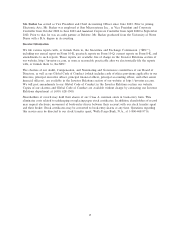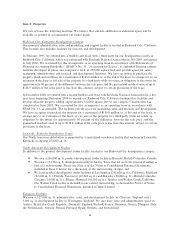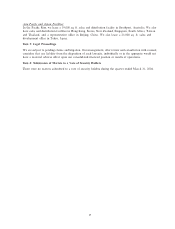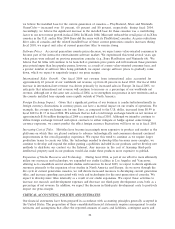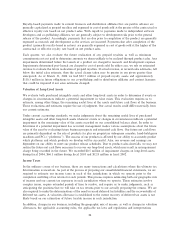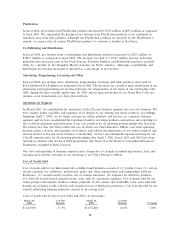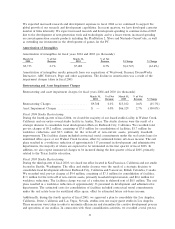Electronic Arts 2004 Annual Report Download - page 38
Download and view the complete annual report
Please find page 38 of the 2004 Electronic Arts annual report below. You can navigate through the pages in the report by either clicking on the pages listed below, or by using the keyword search tool below to find specific information within the annual report.liabilities, and revenue and expenses during the reporting periods. The policies discussed below are considered
by management to be critical because they are not only important to the portrayal of our Ñnancial condition
and results of operations but also because application and interpretation of these policies requires both
judgment and estimates of matters that are inherently uncertain and unknown. As a result, actual results may
diÅer materially from our estimates.
Sales Returns and Allowances and Bad Debt Reserves
We principally derive revenue from sales of packaged interactive software games designed for play on
videogame platforms (such as the PlayStation 2, Xbox and Nintendo GameCube), PCs and hand-held game
machines (such as the Nintendo Game Boy Advance). Product revenue is recognized net of sales allowances.
We also have stock-balancing programs for our PC products, which allow for the exchange of PC products
by resellers under certain circumstances. We may decide to provide price protection for both our personal
computer and videogame system products. In making this determination, we evaluate inventory remaining in
the channel, the rate of inventory sell-through in the channel, and our remaining inventory on hand. It is our
general practice to exchange products or give credits, rather than give cash refunds.
We estimate potential future product returns, price protection and stock-balancing programs related to
current-period product revenue. We analyze historical returns, current sell-through of distributor and retailer
inventory of our products, current trends in the videogame market and the overall economy, changes in
customer demand and acceptance of our products and other related factors when evaluating the adequacy of
the sales returns and price protection allowances. In addition, management monitors and manages the
volume of our sales to retailers and distributors and their inventories, as substantial overstocking in the
distribution channel can result in high returns or substantial price protection requirements in subsequent
periods. In the past, actual returns have not generally exceeded our reserves. However, actual returns and price
protections may materially exceed our estimates as unsold products in the distribution channels are exposed
to rapid changes in consumer preferences, market conditions or technological obsolescence due to new
platforms, product updates or competing products. For example, the risk of product returns for our products
may increase as the PlayStation 2, Xbox and Nintendo GameCube consoles pass the midpoint of their
lifecycle and an increasing number and aggregate amount of competitive products heighten pricing and
competitive pressures. While management believes it can make reliable estimates regarding these matters,
these estimates are inherently subjective. Accordingly, if our estimates changed, our returns reserves would
change, which would impact the net revenue we report. For example, if actual returns were signiÑcantly
greater than the reserves we have established, our actual results would decrease our reported net revenue.
Conversely, if actual returns were signiÑcantly less than our reserves, this would increase our reported net
revenue.
Similarly, signiÑcant judgment is required to estimate our allowance for doubtful accounts in any accounting
period. We determine our allowance for doubtful accounts by evaluating customer creditworthiness in the
context of current economic trends. Depending upon the overall economic climate and the Ñnancial condition
of our customers, the amount and timing of our bad debt expense and cash collection could change
signiÑcantly.
We cannot predict customer bankruptcies or an inability of any of our customers to meet their Ñnancial
obligations to us. Therefore, our estimates could diÅer materially from actual results.
Royalties & Licenses
Our royalty expenses consist of payments to (1) co-publishing and/or distribution aÇliates, (2) content
licensors, and (3) independent software developers. Co-publishing and distribution royalties are payments
made to third parties for delivery of product. License royalties consist of payments made to celebrities,
professional sports organizations, movie studios and other organizations for our use of their trademark,
copyright, personal publicity rights, content and/or other intellectual property. Royalty payments to
independent software developers are payments for the development of intellectual property related to our
games.
23




